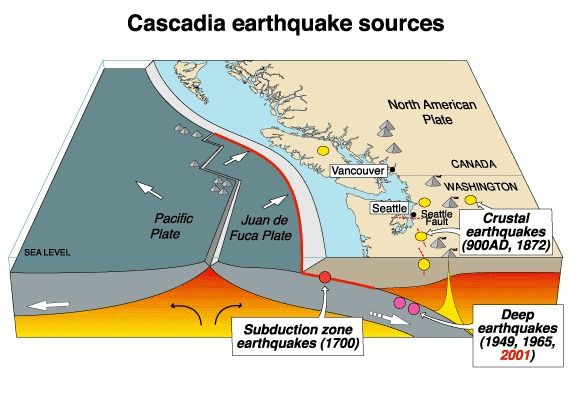
'Slow' Quakes Surprisingly Double Back on Themselves

"Slow earthquakes" are weird enough, with a sluggish pace that is at odds with the better-known quakes that rapidly shift the Earth's surface. Now researchers have discovered yet another strange feature of this recently discovered class of earthquakes. Slow-motion quakes can go backwards. Suddenly, and with more gusto.
These quakes that originate deep in the ground can double back along the path of their rupture.
"It is something that's surprising," said David Shelley, a seismologist with the U.S. Geological Survey. "This is yet another way that tremor migrates, and I think it's going to be a challenge for the community to figure out the physics that underlies this behavior."
Slow-poke rebels
It was already known that slow earthquakes don't act like "regular" quakes — the kind we can feel, whether just forceful enough to knock a picture frame cattywampus, or powerful enough to flatten cities.
Regular earthquakes streak along a fault at about 1.8 miles (3 kilometers) per second, roughly 10 times the speed of sound, whereas slow quakes creep along at about 4.3 mph (7 kph), or about the pace of a brisk walk, and can travel nearly 100 miles (160 km) from start to finish.
Despite their plodding pace, they are no weaklings. The slow-motion quakes of the Washington state area are typically magnitude 6.6 to 6.8. In comparison, the February Christchurch earthquake that toppled buildings and killed 166 people in New Zealand this year was a magnitude 6.1.
Sign up for the Live Science daily newsletter now
Get the world’s most fascinating discoveries delivered straight to your inbox.
However, until slow-motion quakes were recognized in the Pacific Northwest about 10 years ago, nobody knew they existed.
"It's too weak to feel. For a long time people thought it was random noise on the seismometer," said geophysicist Heidi Houston, lead author of a paper documenting the new discoveries about the mysterious quakes. Houston is a University of Washington professor of earth and space sciences.
Curiouser and curiouser
Slow quakes rupture between 22 to 34 miles (35 to 55 km) below the surface of the Earth, far deeper than their faster counterparts. At that depth, Houston said, the massive tectonic plates that cover Earth's surface seem to be gooier, in part possibly due to higher temperatures. That more viscous nature could keep the plates from making the sudden, dramatic moves that produce regular earthquakes closer to the surface.
Another puzzling feature of these slow earthquakes, Houston said, is their consistency. The more commonly known earthquakes occur with maddening irregularity, which is part of what makes them so dangerous. Slow earthquakes appear to follow the beat of an unseen geological drum, occurring roughly every 12 to 15 months in the region of Washington that Houston studies.
While slow-motion quakes already had a reputation as seismological oddballs, it was a surprise to discover they also could suddenly reverse themselves and go backwards, retracing the path they have already ruptured along, Houston said.
"We don't entirely understand why," Houston told OurAmazingPlanet. One possible explanation could be that protruding geological features deep inside the Earth — say, a curve or big rocky bulge where the tectonic plates meet — essentially interrupt the quake and send it racing backwards in its footsteps.
Even more surprising was the discovery that the backwards quakes streak along the fault 20 to 40 times faster than they were moving forward.
Houston thinks that since the quake has already forged a break along the fault, it might be able to retrace its steps with greater speed — but at a pace still 300 times slower than a regular earthquake.
Fuel for the big one?
Though imperceptible, these eccentric quakes aren't mere curiosities, fodder for gee-whiz research. They rupture along the very same fault lines capable of producing devastating megaquakes, such as the recent Japan earthquake, and their behavior may lead to better understanding of their bone-shaking counterparts. [Related: The Japan Earthquake and Tsunami in Pictures]
Houston studies the slow-motion quakes that travel along the Cascadia subduction zone, an active seismic region that stretches from northern California up to Vancouver, where one tectonic plate is being shoved beneath another.
The Cascadia fault is capable of producing monster quakes but hasn't ruptured violently since 1700, when a 9.0 magnitude quake sent a deadly tsunami across the Pacific to Japan.
Shelley, the USGS seismologist, said the slow, deep earthquakes aren't isolated phenomena, though there are many questions about how they relate to big earthquakes.
"It's true that every time you get one of these deep small-slip events, it is slowly ratcheting up the stress on the shallower part"— the part that can produce giant earthquakes, Shelley said.
Both Houston and Shelley said that's reason enough to study slow, backwards earthquakes and try to understand the mechanisms that govern their weird behavior.
"Whether there's going to be any change in that behavior before the next big earthquake, nobody knows," Shelley said, "but it's one more way to keep an eye on what's happening."
The findings of Houston's study were published in the May 22 issue of the journal Nature Geoscience.
- The Biggest Earthquakes in History
- Image Gallery: This Millennium's Destructive Earthquakes
- 7 Ways the Earth Changes in the Blink of an Eye
Andrea Mustain is a staff writer for OurAmazingPlanet, a sister site to LiveScience. Reach her at amustain@techmedianetwork.com. Follow her on Twitter @AndreaMustain.












